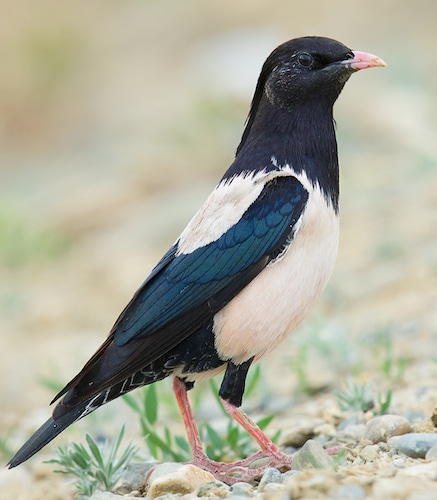Xinjiang Uygher Autonomous Region

Birding Xinjiang
Landlocked Xinjiang, capital Urumqi, is a huge region with three big mountain ranges. These are: the Altai, shared with Russia in the north, the Tien Shan in the centre and the Kunlun-Altun Mountains in the south along the border with India and Pakistan. Between these three mountain ranges are two deserts, with the feared Taklamakan desert in the south being the largest. There the enigmatic Xinjiang (formerly Biddulph’s) Ground Jay still clings to existence, although numbers are declining due to overgrazing and other environmental damage. In some semi-desert areas both Great Bustard and McQueen’s Bustard may still be found. The fringes of the Taklamakan Desert are a place of many ruins of ancient civilizations. Foreign Devils on the Silk Road by Peter Hopkirk is a very readable account of early 20th century archaeological discoveries by foreign adventurers in Xinjiang.Xinjiang has a palearctic avifauna, with many species at the eastern ends of their ranges. European Bee-eater and European Roller are colourful examples. In the far west, at the town of Yili, the former Russian Consulate is now a hotel, set in a compound with mature trees. Here there are Turkestan Tits. In spring the song of Nightingales and Eurasian Cuckoo can be heard.Heaven Lake in the Tien Shan (Heavenly Mountains) is a three-hour drive northeast of the capital. The pines around the lake hold Three-toed Woodpecker, Blue-capped and White-winged Redstarts, Black-throated Accentor and Fire-fronted Serin. South of Urumqi, the oases around the city of Turpan are sites for Azure Tit, Little Owl and Barred Warbler. The biggest nature reserve in China is the Arjinshan National Nature Reserve in the southeast of Xinjiang. It covers 46,000 sq km of steppe, desert and lakes. However, it is remote and undeveloped, with as yet no visitor facilities.Xinjiang was the site of discovery of one of China’s most enigmatic birds. In 1929, near the Karakoram Pass, Dutchman J.A.Sillem shot two specimens of mountain finch that were originally considered to be an odd race of Plain Mountain Finch. In 1992 the specimens were reassessed in Holland and it was decided they should be upgraded to a full species. Live examples of ‘Sillem’s Mountain Finch’ have not been seen in the wild since the original specimens were collected.Xinjiang has a few active birders, some of whom recently found a significant population of the endangered White-headed Duck breeding on reservoirs near Urumqi.No account of birding in Xinjiang would be complete without mention of Professor MA Ming, of the Xinjiang Institute of Ecology and Geography. As well as being a prolific author, Prof. MA is a very well-known and dedicated champion of birds and their habitats throughout this vast region.
-
John & Jemi Holmes
Hong Kong | johnjemi@gmail.com
Website
-
Number of bird species: 585
(As at August 2018)
Number of endemics: 1
Vaurie's Nightjar Caprimulgus centralasicus
-
A Checklist on the Distribution of the Birds in Xinjiang
| By Ma Ming | Huayu Nature Book Trade Co.Ltd | 2011 | Paperback | 244 pages, b/w photos | ISBN: 9787030300461 Buy this book from NHBS.com -
Watch and Research on Birds in Xinjiang
| By Ma Ming | Xinjiang Institute of Ecology and Geography | 2006 | Paperback | 255 pages, Colour photos | Field Guide in Chinese | ISBN: 9787537155403 Buy this book from NHBS.com
-
Xinjiang Bird Watching Society
InformationXinjiang Bird Watching Society, which was established in May 2004, is an NGO with about 40 core members concerning and protecting birds in Xinjiang. It is now under the Xinjiang Ecological Society. Photos and logs...
-
NNR Altun Mountain
InformationSatellite ViewSome of the animals living in great numbers are under the state protection such as wild yak, wild ass, antelope, black-necked crane and snow leopard… -
NNR Bogeda Peak
InformationSatellite ViewAccording to the record, there are 24 species of mammal, 50 species of birds, and 6 species of reptiles, fish and amphibians respectively… -
NNR Motuo
InformationSatellite ViewThe Reserve mainly protects its mountain forests and rare plants and animals… -
NR Xiaerxili
Observatory WebsiteSatellite ViewThere are more than 170 species of terrestrial animals and birds in the protected areas. Among them, there are 16 species belonging to the 1st National level or the 2nd National level of protected wildlife, such as Snow Leopard, North Goat, Saiga antelope, bear, and snow rabbit. There are also 25 species of birds with a Second National level protection designation. 6 species belong to Xinjiang's first and second protected wildlife list.
-
Alpine Birding
Tour OperatorYou want to go birding in your own way, looking for your own target birds, birding in your own pace. We can help you to achieve that, having a birding trip as you wish... -
China Bird Tour
Tour OperatorMr. Tang Jun, owner and founder of China Bird Tour, worked in the travel industry since 1993 and his first experience on birding was from 1999 when the focused his work gradually inclined to birdwatching tourism. Till now his yearly travelling cover all popular birdwatching places within China. -
China Wild Tour
Facebook PageWe are a licensed and professional wilderness guiding company offering premier guided adventure trips for wilderness in China. Our guiding service is specialised in birding but not limited to.
-
2014 [06 June] - Tang Jun
ReportWe started early and drive little bit more than 1 hour and get into Yaozigou Forest park,here we spent most of the morning and saw all our target birds include: Gansu Leaf Warbler,Chinese and White-cheeked Nuthatch, Chinese Bush Warbler,Crested Tit Warbler,Rufous-breasted Accentor, Siberian Rubythroat, Siberian Stonechat, Greenish, Hume’s Leaf and Yellow-streaked Warblers, Elliot’s Laughingthrush, Rufous-vented Tit, Grey-backed Shrike and some other birds. -
2018 [07 July] - James Eaton - Tibetan Plateau & Xinjiang
PDF ReportMany of the birds encountered have exotic names which pay homage to the early explorers of these remote lands; Roborovski’s Rosefinch, Kozlov’s Bunting, Szechneyi’s Monal Partridge, Biddulph’s and Henderson’s Ground-jays, Güldenstädt's Redstart, Severtzov’s Tit-warbler and Przewalski with a partridge, redstart and most significantly for many, a beautiful pink passerine which is now in its own bird family – Prezwalski’s Pinktail. -
2019 [06 June] - Mike Nelson - Tibetan Plateau and Xinjiang
PDF ReportThe quality of the views of most species were particularly good on this tour; beginning in Xinjiang with roadside views of many Biddulph’s Ground Jays, Eversmann’s Redstart, Azure Tit, Red-headed Bunting and Daurian Partridge, conifer valleys revealed Eurasian Three-toed Woodpecker, Fire-fronted Serin and Blue-capped Redstart while arid areas added Tarim Babbler and Desert Whitethroat. A large water body gave us Savi’s and Paddyfield Warblers, Caspian Gull and Bearded Reedling.
-
Northern Xinjiang
WebpageThis post is the first in a five-post series about my birding expedition of July 2017 to Northern Xinjiang.
-
Birds of Xinjiang
BLOG


